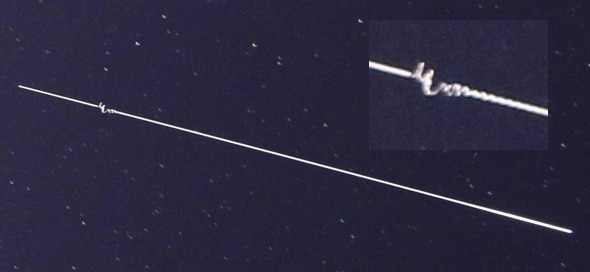Create a free profile to get unlimited access to exclusive videos, sweepstakes, and more!
Nudging the Space Station

One of the things I love about photography in general, and astrophotography in particular, is you never quite know what you’ll get.
Take, for example, Tim Ashby-Peckham, who saw that the International Space Station was going to make a nice pass of his location in the early evening of Nov. 1, 2015. He set up his Canon 70D camera on a tripod, aimed it in the right direction, and waited. Once the ISS came into view, he started snapping away.
I’ve done this myself, many times, and the results can be anywhere from iffy to spectacular. Ashby-Peckham, though, got a lot more than he expected.
Take a look at the photo above. You can see the ISS as a long streak, since it moves a lot during the 30-second exposure. But take a closer look. See the wiggle in the streak at the bottom?
Here, let me enlarge it (I’ve rotated the shot to make it easier to see, and inset a zoom on the piece in question):
Ah, see it now? Clearly, something whacked his tripod during the shot. Again, I’ve ruined many a fantastic photo doing exactly that with my foot (as has pretty much every photographer ever); it’s easy to do when it’s dark out.
But the wiggle doesn’t look like the usual foot-in-tripod result. That usually is more chaotic and has a sharper zig-zag to it, rather than the smoother back and forth seen here.
So what ruined his photo?
An earthquake. Yes, seriously.
Ashby-Peckham took this shot in South Auckland, New Zealand, around 8:57 p.m. local time on Nov. 1, 2015. At 8:58, a magnitude 2.2 earthquake hit a couple of hundred kilometers to the southeast.
Now, skepticism is called for here (the Reddit thread, where I first saw this, has a lot of back and forth about it). Could it be a coincidence? Sure, it could. My strongest doubt was that a quake that weak could be felt that far away. However, in an email discussion about it, Ashby-Peckham told me that another earthquake about the same distance away was indeed felt in Auckland. I’ve been in a couple of earthquakes that size when I lived in northern California, and they were enough to make my closet doors rattle.
From much farther away, it’s not out of the question that one that size could cause a small jiggle in a tripod. Remember, a tripod isn’t perfectly rigid, and it has the weight of the camera all the way on one end. Ask any photographer: A good breeze can cause the tripod to shake (though not likely in this case; the shaking started after the exposure began, lasted less than a second, and then nothing for the rest of the shot).
Usually, it’s maddening. In this case, it was literally Earth-shaking.
So this is a new one on me. Using the ISS as a virtual seismograph! It’s a pretty funny idea. I suppose if you live in a place with enough earthquakes you could actually calibrate your photography equipment to them, measuring how much the image wiggles versus size/distance of the quake. You need a moving target; stars don’t move quickly enough, and all you get is smeared-out disks for them (note that in the shot, the stars do appear to wiggle a bit). Of course, you could put the camera on a motor, letting it slowly scan the sky over and over again.
That seems like a lot of work, but maybe fun work. Or you could, y’know, just get a seismograph. Or just check the USGS quake page. That might work, too.
Tip o’ the lens cap to Peter Caltner.


























